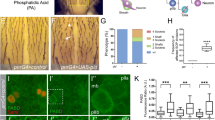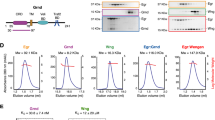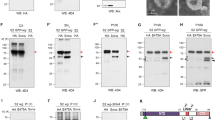Abstract
The c-Cbl proto-oncogene encodes a multidomain phosphoprotein that has been demonstrated to interact with a wide range of signalling proteins. The biochemical function of c-Cbl in these complexes is, however, unclear. Recent studies with the C. elegans Cbl homologue, sli-1, have suggested that Cbl proteins may act as negative regulators of EGF receptor (EGFR) signalling. As the EGFR and other protein tyrosine kinase receptor signalling pathways are highly conserved between insects and vertebrates, we sought a Drosophila homologue of c-Cbl for a detailed genetic analysis. We report here that Drosophila melanogaster has a single gene, D-cbl, that is homologous to c-cbl. We find that D-cbl encodes a 52 kDa protein that has a high degree of similarity to c-Cbl and SLI-1 across novel phosphotyrosine-binding (PTB) and RING finger domains. Surprisingly, however, D-Cbl is C-terminally truncated relative to c-Cbl and SLI-1 and consequently is unable to bind SH3-domain containing adaptor proteins, including the Drosophila Grb2 homologue, Drk. Although the D-Cbl protein lacks Drk binding sites it can nevertheless associate with a tyrosine phosphorylated protein, or is itself tyrosine phosphorylated in an DER dependent manner and associates with activated Drosophila EGF receptors (DER) in vivo. Consistent with a role for D-Cbl in DER dependent patterning in the embryo and adult, D-Cbl is expressed at a high level in early embryos and throughout the imaginal discs in third instar larvae. This study forms the basis for future genetic analysis of D-Cbl, aimed at gaining insights into the role of Cbl proteins in signal transduction.
This is a preview of subscription content, access via your institution
Access options
Subscribe to this journal
Receive 50 print issues and online access
$259.00 per year
only $5.18 per issue
Buy this article
- Purchase on Springer Link
- Instant access to full article PDF
Prices may be subject to local taxes which are calculated during checkout
Similar content being viewed by others
Author information
Authors and Affiliations
Rights and permissions
About this article
Cite this article
Hime, G., Dhungat, M., Ng, A. et al. D-Cbl, the Drosophila homologue of the c-Cbl proto-oncogene, interacts with the Drosophila EGF receptor in vivo, despite lacking C-terminal adaptor binding sites. Oncogene 14, 2709–2719 (1997). https://doi.org/10.1038/sj.onc.1201223
Received:
Revised:
Accepted:
Issue Date:
DOI: https://doi.org/10.1038/sj.onc.1201223
Keywords
This article is cited by
-
Akap200 suppresses the effects of Dv-cbl expression in the Drosophila eye
Molecular and Cellular Biochemistry (2012)
-
Homologs of RUNX and CBFβ/PEBP2β in C. elegans
Oncogene (2004)
-
Cbl: many adaptations to regulate protein tyrosine kinases
Nature Reviews Molecular Cell Biology (2001)
-
Beyond the RING: CBL proteins as multivalent adapters
Oncogene (2001)
-
A Drosophila analogue of v-Cbl is a dominant-negative oncoprotein in vivo
Oncogene (2000)



